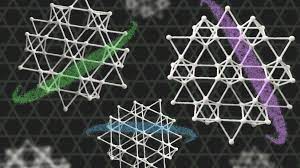The discovery of magnetism could open the door to huge savings

Scientists from Ames National Laboratory and the US Department of Energy’s Oak Ridge National Laboratory conducted an in-depth investigation of the layered Kagome TbMn6Sn6 topological material to better understand its magnetic properties. These findings could influence future technological developments in quantum computing, magnetic storage media, and high-resolution sensors.
Research is discussed in the article Competing low-temperature ferromagnets in topological TbMn6Sn6 ferromagnets, Published in Physical Review X. “kagome” is a type of material whose structure takes its name from the traditional Japanese basket-weaving technique. The weave produces a pattern of hexagons surrounded by triangles and vice versa. The arrangement of atoms in Kagome minerals reproduces the idea of texture. This feature makes the electrons in the material behave in unique ways.

Kagome basket

Kagome structure
Solids have properties Electromagnetic controlled by the electronic band structure. Band structure is strongly dependent on the geometry of the atomic lattice, and sometimes, bands can take on certain shapes, such as cones. These special shapes, called topological features, are responsible for the unique behavior of electrons in these materials. The Kagome structure, in particular, leads to complex and modifiable properties in electronic ranges.
The use of magnetic atoms to build a network of such materials, such as Mn in TbMn6Sn6, can contribute to topological features. Rob McQueen, Ames Laboratory Scientist and Project Director, explained that topological materials “It has a special property in which, under the influence of magnetism, it is possible to obtain currents flowing at the edge of the material, which are devoid of scattering, which means that electrons do not scatter and do not dissipate energy “.
The team sought to better understand TbMn6Sn6’s magnetism and used calculations and neutron scattering data collected by the Oak Ridge Spallation Neutron Source to perform their analysis. Simon Rebrolis, a postdoctoral researcher at Ames Lab and a member of the project team, explained the experimental technique the team used. This technique involves a beam of neutron particles used to check the rigidity of the magnetic arrangement. “The nature and strength of the different magnetic interactions present in the materials can be determined using this technique,” he said.
They found that TbMn6Sn6 has competing interactions between the layers, or so-called frustrated magnetism. “Usually this means that if you turn it on, you can force it to do different things. But what we discovered in this material is that even if there are competing interactions, there are other interactions that are dominant.”
This is the first published detailed investigation into the magnetic properties of TbMn6Sn6. “In research, it’s always exciting when you understand something new or measure something that hasn’t been seen before, partially understood, or different,” said Rebrolis.
McQueeney and Riberolles explained that their results indicate that the material can be tuned to specific magnetic properties, for example by changing Tb to a different rare-earth element, which could alter the compound’s magnetism. This basic research paves the way for continued progress in the discovery of the Kagome minerals.
This is only the first step taken. The results of this search are likely to apply to a list longer than the list above. Electromagnets and electrical coils or wires that rotate around an object create a magnetic field. The main problem is that these wires are long and suffer from “line loss” like heat. Millions of copper wire-based generators are in use today. The use of a metal conductor with a Kagome chassis means that electrical losses and their conversion into heat are kept to a minimum. The potential for energy savings is huge.
These magnets power motors and transformers that provide energy for homes and businesses, as well as a huge list of other applications.
This is an important function of energy saving and to make more power available to reduce electricity. We hope that the work of this team will be accelerated and deliver larger, scalable results very soon.

“Explorer. Devoted travel specialist. Web expert. Organizer. Social media geek. Coffee enthusiast. Extreme troublemaker. Food trailblazer. Total bacon buff.”






